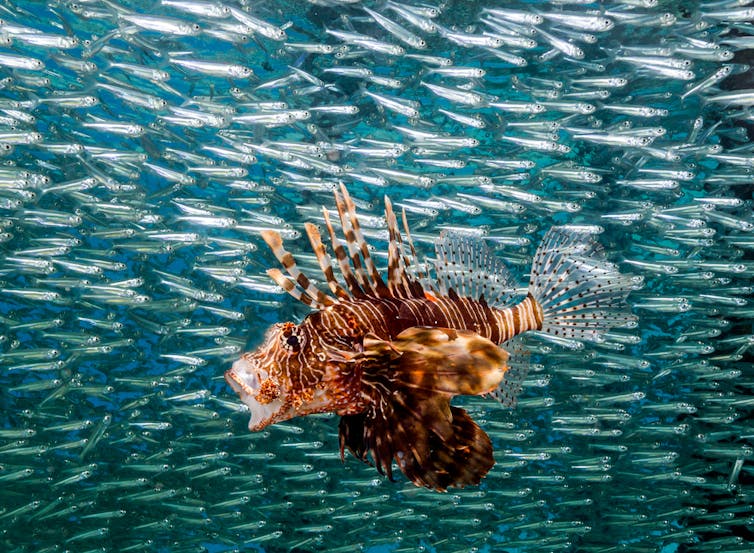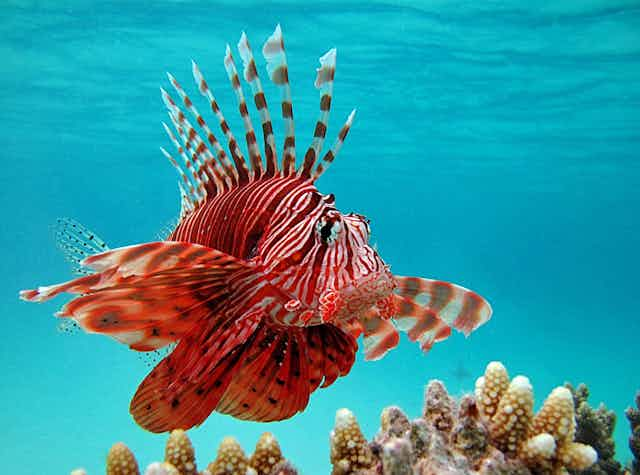The lionfish is a stunning, mesmerising and highly adorned creature that drifts slowly through coral reefs, seemingly unaware of its natural beauty. But it is quickly causing devastation and destruction to the nature it inhabits, decimating biodiversity in the marine environment.
The lionfish hails from the warm, marine waters of the South Pacific and Indian oceans. Here it feeds on a huge variety of prey including smaller fish, molluscs and invertebrates, sometimes blowing water to disorient its prey before consuming them.
The most noticeable feature of the lionfish is the line of spines that runs along the length of its body, with more fanning out from the fins. These spines are striped, brown and white, providing a warning colouration to indicate that they are highly venomous, even to humans. This results in few natural predators, with the exception of moray eels and sharks.
In their natural habitat, lionfish are part of a marine ecosystem that has evolved to interact in harmony, with each species playing a vital role. So, how has the lionfish gradually become responsible for creating havoc across the oceans?
Unfortunately, the lionfish has established populations off south-eastern USA, in the Caribbean and more recently, the Mediterranean. Here, they have essentially invaded the area, preying voraciously on native fish species, increasing rapidly in abundance, and expanding over a vast range.

For example, the first lionfish were reported near Florida in 1985 but by 2001 they had become established across the eastern seaboard of the USA, with densities of more than 100 fish per hectare. Lionfish now outnumber native fish across many sites, and in parts of the western Atlantic are over four times as abundant as they are in their native area.
It is not known exactly how lionfish populations first colonised these locations, but theories include the intentional release from the aquatic trade, and unintentional release through Hurricane Andrew washing captive specimens into the sea, or via boat ballast tanks accidentally containing specimens.
After arriving in a new part of the sea, the lionfish reproduces at an astonishing and alarming rate, capable of spawning every two to three days, all year round. The eggs are released into open water where they hatch and drift in the plankton, before settling onto a reef.
This means there are potentially millions of eggs hitching a ride on the ocean currents for around a month at a time, giving lionfish huge potential to spread fast and wide across a continually moving body of water.
Alongside their voracious appetite – their stomach can expand up to 30 times its size – the local prey are unfamiliar with this new predator, making the new environment an ideal hunting ground. The indirect effects of this include a reduction in prey for the native predators, causing a major imbalance of the ecosystem.
The lionfish also has no known natural predators outside of its native range to keep its populations in check. Even predators of eggs and juvenile lionfish across the globe currently remain unknown.
We are left with the only true predator being humans – and the need to cull lionfish is becoming an urgent priority for conservation. There have been many calls from both nature and economic groups, stating that targeted culling of this invasive species is the only effective way to reduce their numbers.
Hunting the hunter
There are several ways this can happen. Firstly, recreational scuba divers have been trying to keep numbers in check by culling them. But the venomous nature of lionfish means that divers need to be specially trained. Consequently, groups such as the Fraternal Order Of Lionfish Slayers (FOOLS) have been set up to maintain care for divers who can help reduce the amount of lionfish safely.
Some divers are trialling the use of traps to aid safer and more rapid culling of larger numbers. In the Caribbean, the answer to culling has come from researchers at Robots In Service of the Environment (RSE) with their “Lionfish Terminator”.
This robotic zapper has been developed in an attempt to cull lionfish remotely. While there is still a long way to go in terms of full ocean deployment, this could restore the native balance of the ecosystem.
However, another way to control lionfish numbers is to eat them. They are quickly becoming a delicacy on restaurant menus, and have also found their way onto supermarket shelves. Hopefully this opportunistic demand will help to reduce their numbers drastically – but even this could be too little too late.
Eventually, as with all invasive species, the lionfish will find its functional niche and the balance of the ecosystem will be restored. But the current invasion into the Mediterranean has sent a ripple through the natural dynamics of predators and prey, with serious effects on local fisheries and tourism.
We cannot simply wait for balance to be restored. We need to restore the health of the regional marine ecosystems and eradicate such a visually alluring threat before the inevitable apocalyptic destruction.


